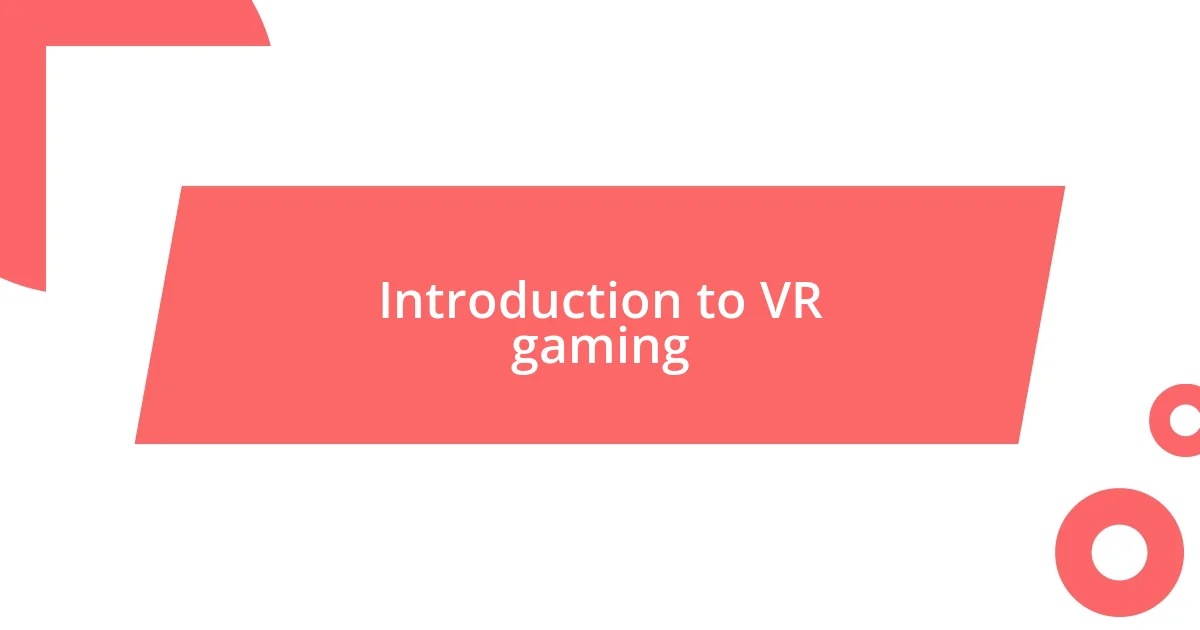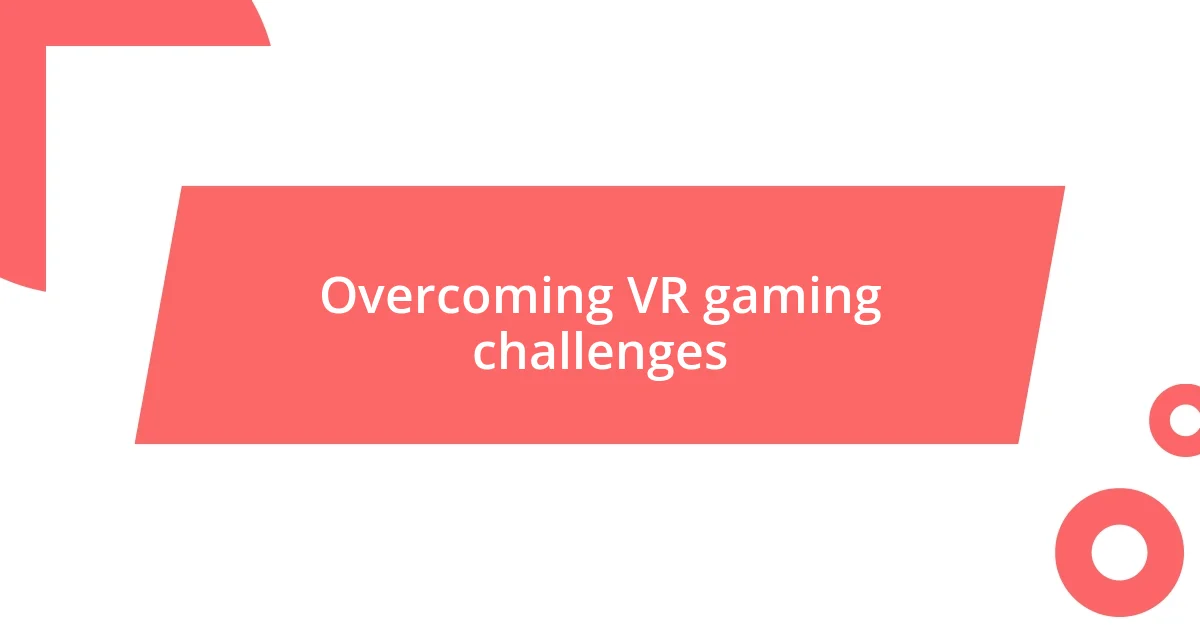Key takeaways:
- VR gaming creates immersive experiences that deeply engage players, enhancing emotional connections through interaction and storytelling.
- Choosing the right VR setup, including headset, controllers, and space, significantly impacts the gaming experience and overall enjoyment.
- The future of VR gaming holds potential for improved social interactions and educational applications, pushing the boundaries of how we play and learn.

Introduction to VR gaming
VR gaming has unleashed a fascinating world where reality intertwines with the digital realm, creating immersive experiences unlike anything I’ve encountered before. Remember the first time you slipped on a VR headset? I still recall the moment I stood in a virtual forest, feeling the weight of the environment around me—it’s an electrifying feeling, isn’t it?
What strikes me most is how VR gaming taps into our senses, making every action feel incredibly real. I once found myself ducking behind cover in a virtual shootout, my heart racing as I could almost feel the heat of the virtual gunfire. Isn’t it mind-blowing how technology can trick our brains into believing we are truly part of another world?
As I navigated through these virtual landscapes, I realized VR isn’t just about the games; it’s about creating emotional connections—whether that’s the thrill of competition or the camaraderie formed in cooperative play. It fosters a sense of presence and connection that I’d never experienced with traditional gaming. Have you ever felt so engaged in a game that it almost felt like you were living it? That’s the magic of VR gaming.

My first VR gaming experience
My first VR gaming experience was nothing short of astonishing. I vividly remember the moment I donned the headset; it was like stepping into another dimension. Suddenly, I found myself soaring through the skies as if I were a bird—wings outstretched, heart racing with exhilaration. That sensation of flight was new to me, and the sheer freedom made me forget the world around me.
As I delved deeper into the game, I encountered challenges that felt remarkably tangible. There was one instance where I had to solve intricate puzzles while battling immersive landscapes, and I could almost feel my pulse quicken with each twist and turn. It made me question: how could mere pixels evoke such adrenaline? The answer lies in the immersive power of virtual reality; it’s as if you’re not just playing a game, but truly living and experiencing a narrative firsthand.
Reflecting back, I realized that my initial VR encounter ignited a passion for immersive storytelling. The emotional highs and lows I felt throughout the gameplay were profound. It taught me the importance of connection—whether through the stunning graphics or the interactive elements that let me shape my own journey. Have you ever immersed yourself so deeply in a virtual world that you lost track of time? That was precisely what happened to me.
| Element | Description |
|---|---|
| Immersion | Feeling of stepping into another world |
| Emotional Response | Adrenaline rush during gameplay |

Choosing the right VR setup
Choosing the right VR setup can feel overwhelming, but it’s essential for a fulfilling experience. I remember sifting through countless options, trying to determine the perfect combination of hardware and software. The headset, the controllers, and even the space you have available play crucial roles. It’s fascinating how the right setup can elevate your gaming experience from merely playing to genuinely living within the game.
When I finally settled on my VR setup, I made sure to consider the following aspects:
- Headset: Evaluate the resolution, field of view, and comfort level; I opted for one that offered great visuals without making my head feel heavy.
- Controllers: Choose ones that are intuitive and responsive. A good grip can make all the difference; I learned this when I struggled with a less responsive controller in a fast-paced game.
- Space Requirements: Ensure you have enough room to move around safely. I had to rearrange my gaming space to avoid knocking over furniture while dodging virtual obstacles.
- Game Library: Look for a setup that offers a wide selection of games that appeal to your tastes; I found my favorites by trying out demo versions first.
It’s like crafting your personal escape; finding the right VR setup brings that world to life in ways you would never imagine.

Exploring different VR games
Exploring different VR games is like opening a treasure chest filled with unique experiences. For instance, I recently dived into a rhythm game where I had to slice through blocks to the beat of catchy music. The rush I felt, fully immersed in that vibrant world, was exhilarating! It made me think: how incredible is it that music can synchronize perfectly with physical movement, creating a gameplay experience that feels both athletic and artistic?
Then there are narrative-driven games that pull at your heartstrings. I remember playing a story set in a picturesque village where my choices influenced the outcome of the tale. Each decision I made, from whom to help to how to navigate conflicts, brought a wave of emotions. Have you ever felt genuinely attached to a character—so much so that their struggles felt like your own? That’s the magic of VR; it blurs the lines between reality and the virtual, making you care in ways you might never expect.
Lastly, the variety in VR gaming is almost astounding. I’ve tried everything from intense horror games that had me literally jumping out of my seat to calming explorative experiences that allowed me to wander through stunning landscapes. Each genre offers something distinct, and exploring this diversity has truly broadened my perspective on gaming. Which genres resonate with you? I’ve found that my preferences often shift depending on my mood, making the journey of exploration even more enriching.

Tips for an immersive experience
Creating an immersive VR experience goes beyond just the hardware; it’s also about the environment you set up around you. I learned the hard way that lighting can dramatically impact how immersed you feel—bright lights reflecting on the headset can distract you from the adventure. Dim lighting not only enhances the visuals but also encapsulates you within the virtual realm, making everything come alive. Have you ever noticed how the smallest distractions can pull you right out of a fantastical world?
Another tip I swear by is to integrate physical movement into your VR sessions. Initially, I would just stand still, but once I threw myself into full-body movements, the games felt completely different. I found myself genuinely ducking and dodging instead of simply pressing a button—my heart raced as I felt the adrenaline surge. This level of engagement not only enhances enjoyment but also makes your body an active part of the story, immersing you in ways that sitting passively never could. What’s your take on active participation? I think it truly transforms how one experiences gameplay.
Finally, don’t underestimate the power of sound. Investing in quality headphones was a game-changer for my immersion. The first time I put on my noise-canceling headphones and dove into a horror game, I realized how sound can amplify fear, excitement, and emotional connection. Each creak and rustle echoed in my ears, making me jump at even the slightest cue. Have you ever put on a headset and felt the world around you disappear? It’s in those moments that VR transcends mere gaming and becomes an all-encompassing journey.

Overcoming VR gaming challenges
Navigating the challenges of VR gaming can sometimes feel like an adventure in itself. I recall the moment I first experienced motion sickness while playing a fast-paced game. The world spun, and I felt queasy, but I didn’t want to give up. So, I explored different comfort settings within the game and even took breaks to adjust to the VR environment. Surprisingly, with patience and a bit of trial and error, I learned that slowly building up my time in VR helped my body acclimate. Have you ever pushed through discomfort to find a rewarding experience on the other side?
On another occasion, I faced technical challenges that felt overwhelming. There was a frustrating day when my headset wouldn’t connect, and I was convinced I’d never get to experience that new game I had been so excited about. Instead of throwing in the towel, I took a moment to breathe and turned to online communities for troubleshooting advice. I was amazed at the support and tips I found; it transformed my initial frustration into a collaborative problem-solving session. Does it feel good to know there’s a whole community out there ready to help when technology throws a curveball?
Lastly, I can’t emphasize enough the importance of finding the right physical space for VR. Initially, I was trying to play in a cramped room filled with furniture, which made me feel confined and anxious. It took a bit of rearranging, but once I cleared the area and created a safe zone, everything changed. Suddenly, I felt liberated to move around freely, fully embracing the virtual worlds I was exploring. Have you experienced the liberation of having a dedicated space? The right environment can transform VR gaming from a simple activity into an exhilarating escape.

The future of VR gaming
The future of VR gaming is undeniably exciting, as advancements in technology continue to bridge the gap between the virtual world and reality. I remember the first time I stepped into a VR environment that used hand-tracking—it was as if my own hands were part of a different realm. The sense of presence felt so natural, but what if future systems could track our emotions too? Imagine a game that adapts based on how you feel; wouldn’t that be a game-changer?
As I look ahead, I can’t help but ponder about multiplayer experiences. When I played a VR game with friends online, there was a palpable magic in working together to solve puzzles. The laughter and camaraderie felt so real, even though we were miles apart. It makes me wonder: how will social interactions evolve in VR? Perhaps we’ll soon attend virtual concerts, making the distance between us vanish while we share the thrill of live performances.
And then there’s the potential for educational applications. I once had a jaw-dropping experience learning about history through an immersive VR simulation, walking the streets of ancient Rome. It was a blend of learning and play that I never knew I needed. Could this mean an evolution in how we conduct training and education? I truly believe we’re on the cusp of a transformation that will redefine not only gaming but how we learn and connect with one another.















